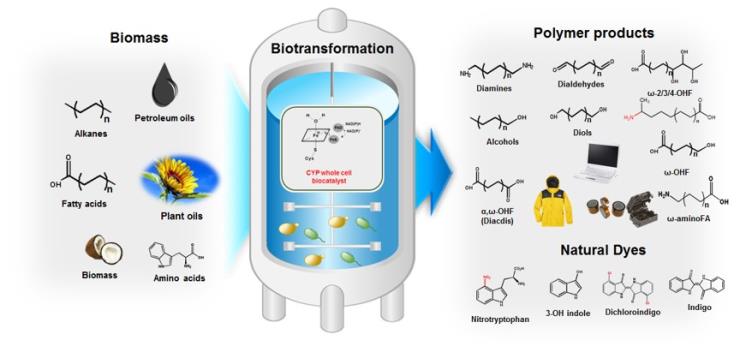-
Professor Choi Kwon-yeong (pictured left) and his team in the Department of Environmental Engineering have successfully developed a novel biotechnology for the production of coloring dye that uses a specific enzyme that facilitates eco-friendly bioprocesses. This eco-friendly biotechnology for coloring dye production, using a specific enzyme known as cytochrome P450 (CYP), was featured in an article entitled “Whole-cell biocatalysis using cytochrome P450 monooxygenases for biotransformation of sustainable bioresources (fatty acids, fatty alkanes, and aromatic amino acids),” which was published in the journal Biotechnology Advanced (IF = 12.831) on January 8, 2020. The principal author of the article is Park Hyeon-ah (pictured right, doctoral candidate in environmental engineering). The article was listed among the academic articles that “shine light on Korea,” which were handpicked by Korea’s Biological Research Information Center (BRIC). Professor Choi’s team has been researching the use of CYP enzymes, which are involved in oxidation-induced detoxification, in the production of high-molecular-weight bioresources, such as polyesters and polyamides, from biomasses such as fatty acids and amino acids. Capable of mediating oxidation by taking electrons from oxygen and nitrite reductases (NAD(P)H), CYP monooxygenases hold great potential for productive industrial applications. In their latest study, Professor Choi’s team demonstrates how CYP enzymes can be used to turn a wide range of bioresources into popular high-molecular-weight monomers through an eco-friendly process. As biocatalysts, CYP enzymes are amenable to a variety of engineering methods, including enzymatic and metabolic engineering, and can therefore be applied to cost-competitive, eco-friendly processes. CYP enzymes have been garnering much attention in recent research on eco-friendly bioprocesses because they can be synthesized with various chemical compounds to produce high-molecular-weight bioresources. However, wide industrial use of the enzymes has not been feasible until now due to a number of real-world constraints, such as the difficulty of recycling NAD(P)H, the question of how to supply electron-delivering redox proteins, and the compromised economic feasibility of injecting heme precursors. In the article, Professor Choi’s team analyzes the currently achievable level of CYP-based biocatalysis transformation of biochemical processes and explains the wide range of engineering challenges that need to be overcome. The team continues to study the production of biodegradable high-molecular-weight compounds using CYP enzymes, with a particular focus on solving the problem of plastic waste. A number of papers on related topics have already been published in Dyes and Pigments, one of the most prestigious textile engineering journals worldwide.
-
0
- 작성자통합 관리자
- 작성일2020-03-08
- 5526
- 동영상동영상

